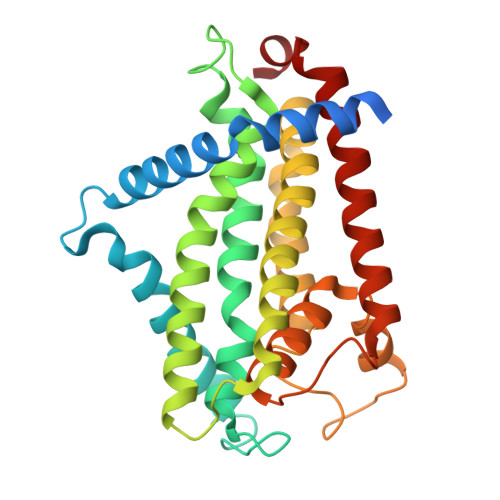Cryo-EM analyses unveil details of mechanism and targocil-II mediated inhibition of S. aureus WTA transporter TarGH.
Li, F.K.K., Peters, S.C., Worrall, L.J., Sun, T., Hu, J., Vuckovic, M., Farha, M., Palacios, A., Caveney, N.A., Brown, E.D., Strynadka, N.C.J.(2025) Nat Commun 16: 3224-3224
- PubMed: 40185711
- DOI: https://doi.org/10.1038/s41467-025-58202-w
- Primary Citation of Related Structures:
9CFL, 9CFP, 9MHD, 9MHU, 9MHZ - PubMed Abstract:
Wall teichoic acid (WTA) is a polyol phosphate polymer that covalently decorates peptidoglycan of gram-positive bacteria, including Staphylococcus aureus. Central to WTA biosynthesis is flipping of lipid-linked precursors across the cell membrane by TarGH, a type V ABC transporter. Here, we present cryo-EM structures of S. aureus TarGH in the presence of targocil-II, a promising small-molecule lead with β-lactam antibiotic synergistic action. Targocil-II binds to the extracellular dimerisation interface of TarG, we suggest mimicking flipped but not yet released substrate. In absence of targocil-II and in complex with ATP analogue ATPγS, determined at 2.3 Å resolution, the ATPase active site is allosterically inhibited. This is due to a so far undescribed D-loop conformation, potentially minimizing spurious ATP hydrolysis in the absence of substrate. Targocil-II binding comparatively causes local and remote conformational changes through to the TarH active site, with the D-loop now optimal for ATP hydrolysis. These structures suggest an ability to modulate ATP hydrolysis in a WTA substrate dependent manner and a jammed ATPase cycle as the basis of the observed inhibition by targocil-II. The molecular insights provide an unprecedented basis for development of TarGH targeted therapeutics for treatment of multidrug-resistant S. aureus and other gram-positive bacterial infections.
- Department of Biochemistry and Molecular Biology and the Centre for Blood Research, University of British Columbia, Vancouver, BC, Canada.
Organizational Affiliation:




















